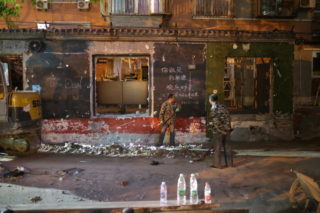September 22, 2017 / Jeroen de Kloet
Smart Nostalgia in Sustainable Beijing

| Principle Investigator: | Jeroen de Kloet |
| Institution: | University of Amsterdam |
They appeared like magic, all over the city of Beijing, the public telephone booths with their characteristic shape. They always come in pairs, the retro-futuristic orange covers are gently touching one another. The booths appeared somewhere in the 1990s, and I remember my exhilaration, to me they signified a Beijing ushering towards an exciting yet unknown future. A smart Beijing, in which we could always remain in touch with one another. Twenty years later they are still around, rendered obsolete due to the mobile phone. They are like lonely and dusty reminders of a time past, a dakou time, when new sounds, films and technologies entered China through the illegal backdoor.
For me, Beijing is above all a nostalgic city. Its nostalgia is not as much mapped onto a longing for an innocent past – there is no such a thing as an innocent past, certainly not in China – but merely involves a heightened awareness of the passing of time. When one returns to Beijing, it is easy to lose your way, as a park has become a building, and a building has become a ring road. Coming from a city that is drenched, and on more gloomy days I may even think frozen, in its history – Amsterdam – this frantic speed of changes is bewildering, exciting as well as alienating.
Oh, Beijing, why can’t you stay the same, why must that shop be closed, why is that hutong being torn down, why yet another shopping mall, and aren’t six ring roads enough? According to Svetlana Boym (2001: 21), “nostalgia inevitably reappears as a defense mechanism in a time of accelerated rhythms of life and historical upheavals.”(Boym 2001:21) My bewilderment may thus as well be a defense mechanism, or it may be propelled by an orientalistic amazement about the possibility of such a speed of changes. In Amsterdam, it takes fifteen years to build a subway with eight stops. In Beijing, well, we know what happened to its subway in only fifteen years’ time.
To think of Beijing as a sustainable city seems rather scandalous and obscene, as everything solid continues to melt into the thin air of a belief in and commitment to progress. But today, it is one of the buzzwords that circulates in the city, together with other signifiers like “smart”, “creative” and “innovative.” When, on a hot spring day in May 2017, I biked around Wangjing district, I came across my beloved phone booth, torn out from the street, laying there, hopeless and useless at the same time. This is what smart technologies do: in their development, they are quickly rendered obsolete, sometimes planned by the company as to make more money (think of our iPhones and Macbooks), at other times not planned but nevertheless inevitable. The smart city thus produces large amounts of e-waste, of toxic leftovers that threaten our lives.
The smart city may be not so smart after all, and the surrounding rhetoric of sustainability – after all, if it is smart, it has to be sustainable, right? – may serve mainly as a veil to cover up the interests of those who produce the smart city: designers, companies, and governments.
Nostalgia may thus serve not so much as a defense mechanism as it is the canarie in the coal mine. While sitting on the fence of time called nostalgia, to paraphrase Helen Hok-sze Leung, we are confronted with the awareness that so much of the past has been rendered obsolete and useless, so much is gone, so many materials were turned into waste, all the labor that has evaporated into the facades of capital. What is left are toxic traces and broken lives. This is not smart. This is not sustainable. This is Beijing.


